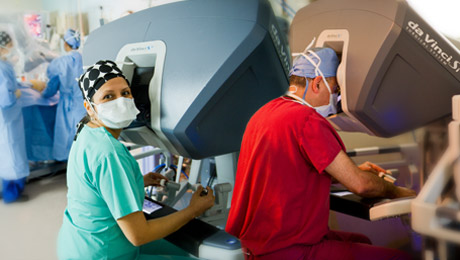Robotic and Minimally Invasive Gynecological Surgery
When medication and non-invasive procedures are unable to relieve symptoms, surgery remains the accepted and most effective treatment for a range of gynecologic conditions. These include, but are not limited to, cervical and uterine cancer, uterine fibroids, endometriosis, uterine prolapse and menorrhagia or excessive bleeding.
Traditional open gynecologic surgery, using a large incision for access to the uterus and surrounding anatomy, has for many years been the standard approach to many gynecologic procedures. Yet open surgery has its drawbacks. Fortunately, less invasive options are available in many cases.

For the patient, the benefits of minimally invasive procedures may include:
- Significantly less pain
- Less blood loss
- Less scarring
- Shorter recovery time
- A faster return to normal daily activities
- And in many cases, better clinical outcomes
For complex hysterectomies and other gynecologic procedures, robot-assisted surgery with the da Vinci® Surgical System may be the most effective, least invasive treatment option. Through small, 1-2 cm incisions, surgeons using the da Vinci System* can operate with greater precision and control, minimizing the pain and risk associated with large incisions while increasing the likelihood of a fast recovery and excellent clinical outcomes.
About the UTMB Health Robotic Gynecology Program
At UTMB Health, we are aware that a high level of surgical skill alone
is not enough to take care of a whole person; we realize great technical
and clinical expertise must be balanced with the ability to connect
with people. We are here to listen, to hear, to explain and understand.
We're not just about taking care of a problem; we understand we're here
to help improve your quality of life.
Members of the Robotic Gynecology clinical care team make up
the Minimally Invasive Gynecology and Research Program at the University
of Texas Medical Branch. It's a group that works hard to stay up to
date with the latest technology, best practices and most effective
treatments for many women's health issues. We work together, and focus
entirely on what is best for you, the patient. We perform a wide array
of gynecological procedures using minimally invasive and
robotic-assisted techniques, including more than 400 hysterectomies each
year.
Minimally invasive surgery offers patients a host of advantages over
open surgery, including quicker recovery time, less blood loss, less
pain and a shorter hospital stay. For many women, it's worth
investigating.
If you are considering an open hysterectomy, we invite you to please
visit us for a consult or second opinion. One of our expert
gynecologists may be able to offer you a hysterectomy performed
laparoscopically or with robotic assistance. As a team affiliated with a
major university medical center, we routinely resolve high risk or
complicated cases referred to us from as far away as Beaumont and Corpus
Christi. Take advantage of our experience and our whole-woman approach
to get great care and a speedy return to a happy, healthy and productive
life.
 The
University of Texas Medical Branch is one of only four hospitals in
Texas to receive the Center of Excellence in Minimally Invasive
Gynecology designation, signifying the highest level of laparoscopic
gynecological expertise. The AAGL — the world’s premier professional
society dedicated to minimally invasive surgery in gynecology — has
designated only 44 Centers of Excellence in the United States. [Read more]
The
University of Texas Medical Branch is one of only four hospitals in
Texas to receive the Center of Excellence in Minimally Invasive
Gynecology designation, signifying the highest level of laparoscopic
gynecological expertise. The AAGL — the world’s premier professional
society dedicated to minimally invasive surgery in gynecology — has
designated only 44 Centers of Excellence in the United States. [Read more]
Minimally Invasive Procedures
-
Hysterectomy
Physicians perform hysterectomy – the surgical removal of the uterus – to treat a wide variety of uterine conditions. Each year in the U.S. alone, doctors perform approximately 600,000 hysterectomies, making it the second most common surgical procedure. [Read more]
-
Uterine conditions & treatment
When a woman faces a medical condition that affects her uterus, the hollow, muscular organ that holds and feeds a fertilized egg, the emotional impact can often be as challenging as the physical. These conditions include, but are not limited to, cervical and uterine cancers such as endometrial cancer, uterine fibroids, uterine prolapse, excessive bleeding and endometriosis. Treatment options are as varied as the conditions themselves, depending on individual circumstances. A woman’s age, health history, surgical history and diagnosis (benign or cancerous), all factor into the recommended course of action. [Read more]
-
Fibroids & treatment options
Uterine fibroids* are benign (non-cancerous) tumors occurring in at least one quarter of all women.1 They can grow underneath the uterine lining, inside the uterine wall, or outside the uterus. Many women don’t feel any symptoms with uterine tumors or fibroids. But for others, these fibroids can cause excessive menstrual bleeding (also called menorrhagia), abnormal periods, uterine bleeding, pain, discomfort, frequent urination and infertility. [Read more]
-
Other procedures offered
- Robotic salphygo-oophorectomy (surgical removal of a fallopian tube and an ovary, often performed to treat ovarian or other gynecological cancers, or infections caused by pelvic inflammatory disease. Occasionally, removal of one or both ovaries may be done to treat endometriosis)
- Robotic endometriosis excision (treatment for endometriosis, a female health disorder that occurs when cells from the lining of the womb (uterus) grow in other areas of the body.)
- Robotic myomectomy: Removal of uterine fibroids through small incisions
- Robotic abdominal cerclage: A surgical procedure in which the opening to the uterus (the cervix) is stitched closed in order to prevent a miscarriage or premature birth.
- Robotic Burch (surgical treatment for stress incontinence)
- Robotic sacrocolpopexy (procedure to surgically correct vaginal vault prolapse where mesh is used to hold the vagina in the correct anatomical position. This procedure can also be performed following a hysterectomy to treat uterine prolapse to provide long-term support of the vagina.)
- Robotic appendectomy
- Robotic metroplasty (uterine restoration)
- Robotic Luna procedure (for pelvic pain)
- Robotic high uterosacral fixation (for pelvic prolapse)
- Robotic trachelectomy (surgical removal of the cervix)
- Laparoscopic/Robotic bladder/bowel repair
- Tubal reanastomisis (tubal ligation reversal)